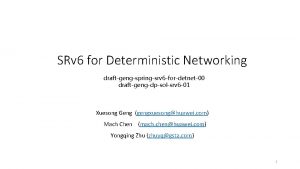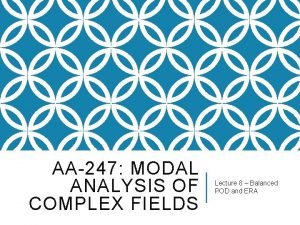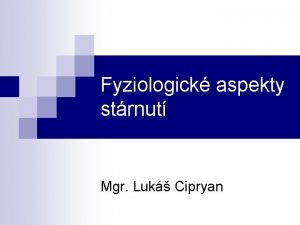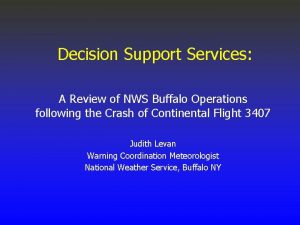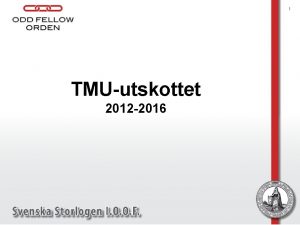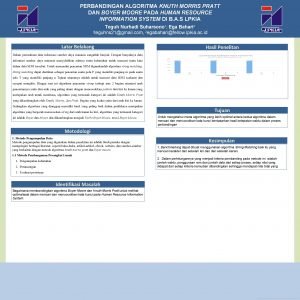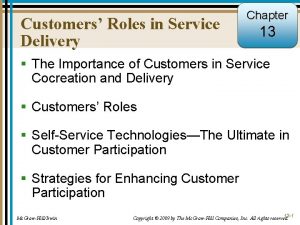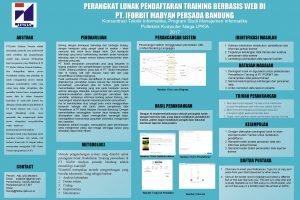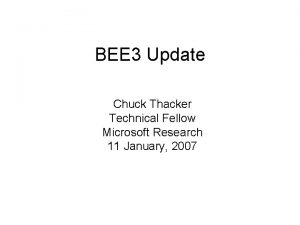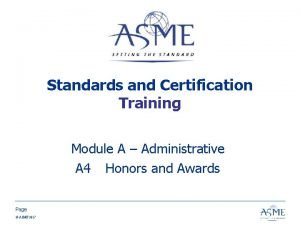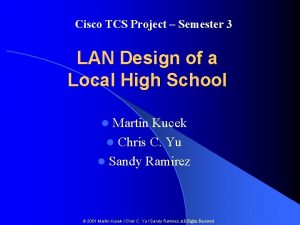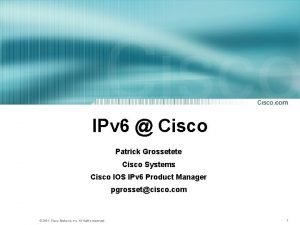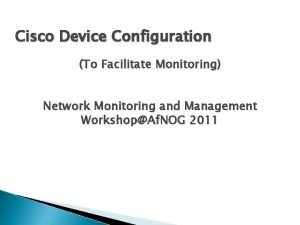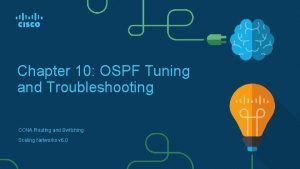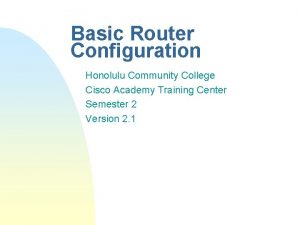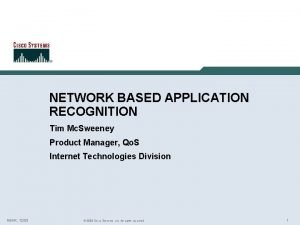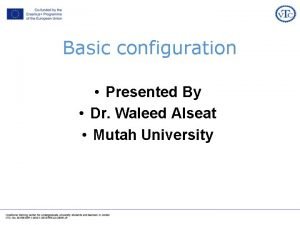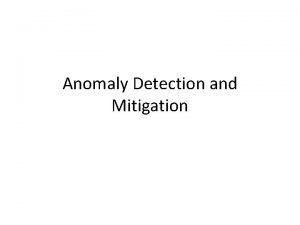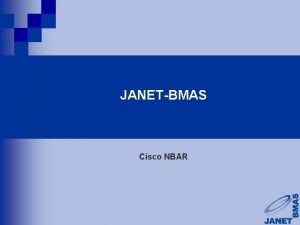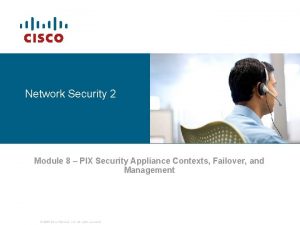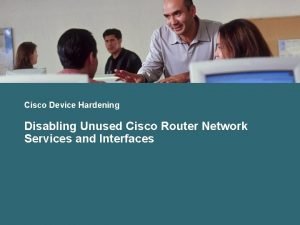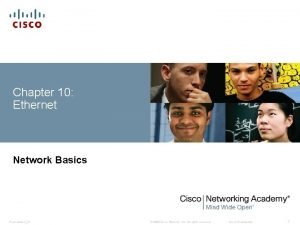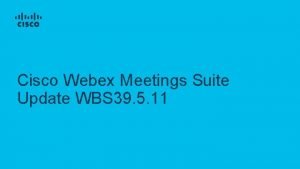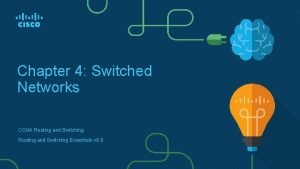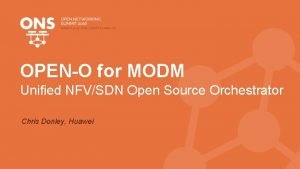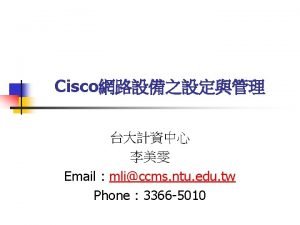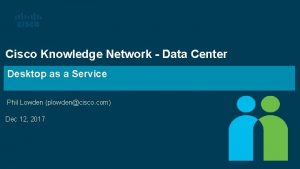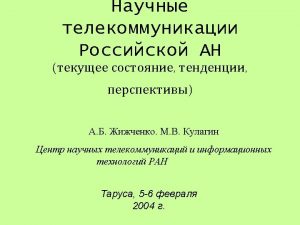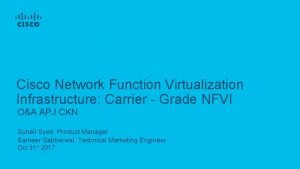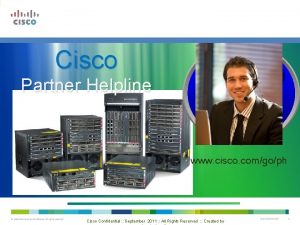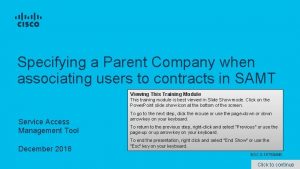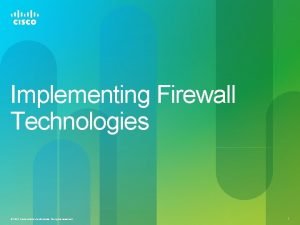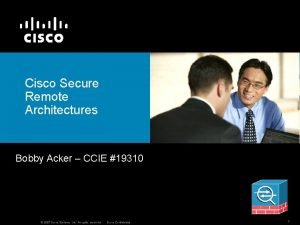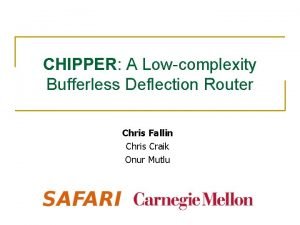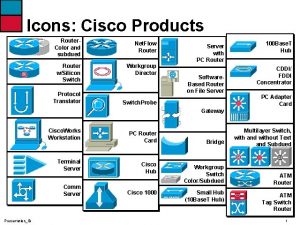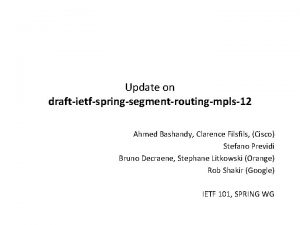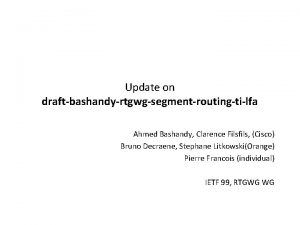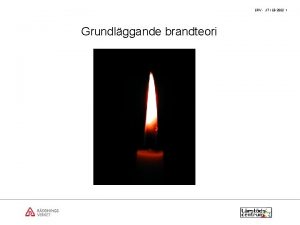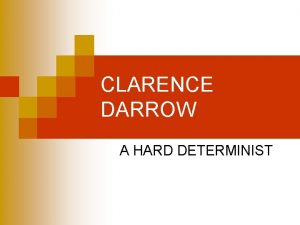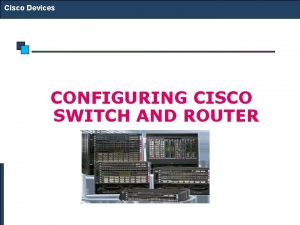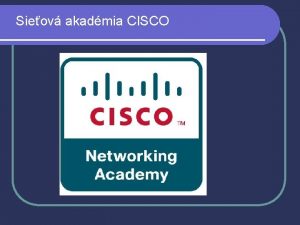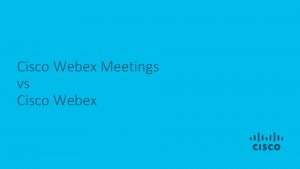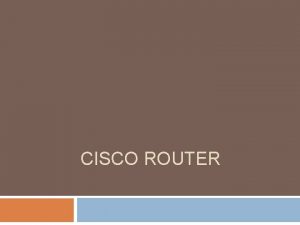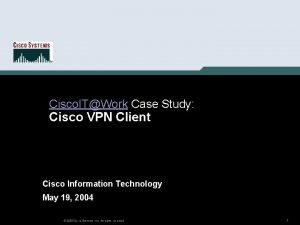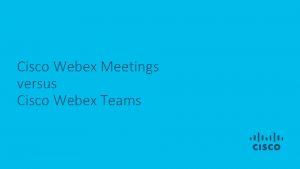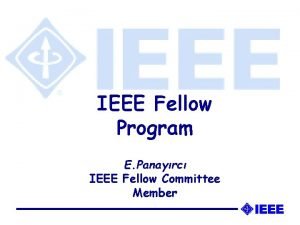SRv 6 Clarence Filsfils Cisco Fellow cfcisco com











































































- Slides: 75

SRv 6 Clarence Filsfils Cisco Fellow - cf@cisco. com

Segment Routing • Source Routing – the topological and service (NFV) path is encoded in the packet header • Scalability – the network fabric does not hold any per-flow state for TE or NFV • Simplicity – automation: TILFA – protocol elimination: LDP, RSVP-TE, NSH… • End-to-End – DC, Metro, WAN © 2014 Cisco and/or its affiliates. All rights reserved. 2

Industry at large backs up SR Strong customer adoption WEB, SP, Enterprise Standardization IETF De-Facto SDN Architecture Multi-vendor Consensus Interop testings © 2014 Cisco and/or its affiliates. All rights reserved. 3

Objective of SRv 6

IPv 6 provides reachability Micro-services Io. T services IP 5 G 4 G Metro/Core Network Legacy DC Next-Gen Data Center x. DSL FTTH 5 G 5 G Cable Source Address Support 5 G growth IPv 6 addresses summarization Destination Address Support container adoption for micro-services IPv 6 © 2014 Cisco and/or its affiliates. All rights reserved. 5

SRv 6 for underlay SRv 6 for Underlay RSVP for FRR/TE Horrendous states scaling in k*N^2 Simplification, FRR, TE, SDN IPv 6 for reach © 2014 Cisco and/or its affiliates. All rights reserved. 6

Opportunity for further simplification NSH for NFV UDP+Vx. LAN Overlay SRv 6 for Underlay Additional Protocol and State Additional Protocol just for tenant ID Simplification, FRR, TE, SDN IPv 6 for reach • Multiplicity of protocols and states hinder network economics © 2014 Cisco and/or its affiliates. All rights reserved. 7

Network Programming

Network instruction Locator Function(arg) Function • 128 -bit SRv 6 SID – Locator: routed to the node performing the function – Function: any possible function (optional argument) either local to NPU or app in VM/Container – Flexible bit-length selection © 2014 Cisco and/or its affiliates. All rights reserved. 9

Network Program in the packet header IPv 6 Header Segment Routing Header IPv 6 Payload Source Address Next Segment Destination Address Locator 1 Function 1 Locator 2 Function 2 Locator 3 Function 3 TCP, UDP, QUIC… © 2014 Cisco and/or its affiliates. All rights reserved. 10

Network Program Next Segment Locator 1 Function 1 Locator 2 Function 2 Locator 3 Function 3 Locator 2 Locator 1 Function 2 Locator 3 © 2014 Cisco and/or its affiliates. All rights reserved. Function 3 11

Network Program Next Segment Locator 1 Function 1 Locator 2 Function 2 Locator 3 Function 3 Locator 2 Locator 1 Function 2 Locator 3 © 2014 Cisco and/or its affiliates. All rights reserved. Function 3 12

Network Program Next Segment Locator 1 Function 1 Locator 2 Function 2 Locator 3 Function 3 Locator 2 Locator 1 Function 2 Locator 3 © 2014 Cisco and/or its affiliates. All rights reserved. Function 3 13

Argument shared between functions Locator 1 Function 1 Argument 1 Locator 2 Function 2 Argument 2 Locator 3 Function 3 Argument 3 “Global” Argument Metadata TLV © 2014 Cisco and/or its affiliates. All rights reserved. 14

Group-Based Policy TAG Locator 1 Function 1 Argument 1 Locator 2 Function 2 Argument 2 Locator 3 Function 3 Argument 3 Metadata TLV © 2014 Cisco and/or its affiliates. All rights reserved. 15

SR Header TAG Segments Left Locator 1 Function 1 Locator 2 Function 2 Locator 3 Function 3 Metadata TLV © 2014 Cisco and/or its affiliates. All rights reserved. 16

SRv 6 for anything TAG Segments Left Locator 1 Function 1 Locator 2 Function 2 Locator 3 Function 3 Turing Metadata TLV © 2014 Cisco and/or its affiliates. All rights reserved. 17

SRv 6 for anything TAG Segments Left Locator 1 Function 1 Locator 2 Function 2 Locator 3 Function 3 Optimized for HW processing e. g. Underlay & Tenant use-cases Optimized for SW processing e. g. NFV, Container, Micro-Service Metadata TLV © 2014 Cisco and/or its affiliates. All rights reserved. 18

Lead Operators • Standardization • Multi-Vendor Consensus © 2014 Cisco and/or its affiliates. All rights reserved. 19

© 2014 Cisco and/or its affiliates. All rights reserved. 20

SRv 6 for Next-generation Mobile © 2014 Cisco and/or its affiliates. All rights reserved. 21

Use-Cases

SID allocation for illustration purpose • For simplicity • Node K advertises 12 10 prefix AK: : /64 • The function is encoded in the last 64 bits A 1: : /64 2 4 1 7 13 3 11 6 5 A 5: : /64 14 DC WAN © 2014 Cisco and/or its affiliates. All rights reserved. PEER 23

Endpoint • For simplicity • Function 0 denotes 12 10 the most basic function • Shortest-path to A 1: : 0 2 4 1 7 13 the Node 3 11 6 5 A 5: : 0 14 DC WAN © 2014 Cisco and/or its affiliates. All rights reserved. PEER 24

A 1: : 0 and then A 5: : 0 12 10 A 1: : 0 2 4 1 7 13 3 11 6 5 A 5: : 0 14 DC WAN © 2014 Cisco and/or its affiliates. All rights reserved. PEER 25

Endpoint then xconnect to neighbor • For simplicity • AK: : CJ denotes Shortest-path to the Node K and then x-connect (function C) to the neighbor J 12 10 A 1: : C 2 2 4 1 7 13 3 6 5 A 5: : C 7 11 14 DC WAN © 2014 Cisco and/or its affiliates. All rights reserved. PEER 26

A 1: : 0 and then A 5: : C 7 12 10 A 1: : 0 2 4 1 7 13 3 6 5 A 5: : C 7 11 14 DC WAN © 2014 Cisco and/or its affiliates. All rights reserved. PEER 27

TILFA 2 100 4 • 50 msec Protection upon local link, node or SRLG failure • Simple to operate and understand 1 6 – automatically computed by the router’s IGP process 5 A 5: : 0 – 100% coverage across any topology – predictable (backup = postconvergence) • Optimum backup path – leverages the post-convergence path, planned to carry the traffic A 5: : /64 Pri → via 5 FRR → insert A 2: : C 4 – avoid any intermediate flap via alternate path • Incremental deployment • Distributed and Automated Intelligence © 2014 Cisco and/or its affiliates. All rights reserved. 28

INSERT A 2: : C 4 TILFA 2 100 4 A 5: : 0 • 50 msec Protection upon local link, node or SRLG failure • Simple to operate and understand – automatically computed by the router’s IGP process 1 6 A 5: : 0 5 <50 mec FRR – 100% coverage across any topology – predictable (backup = postconvergence) • Optimum backup path – leverages the post-convergence path, planned to carry the traffic – avoid any intermediate flap via alternate path • Incremental deployment • Distributed and Automated Intelligence © 2014 Cisco and/or its affiliates. All rights reserved. 29

Overlay IPv 6 ( T: : 1, V: : 1 ) payload • Simple – Protocol elimination • Automated – No tunnel to configure • Efficient – SRv 6 for everything – Reuse BGP/VPN signaling T/64 3 1 Green Overlay V/64 via A 2: : C 4 IPv 6 ( A 1: : 0, A 2: : C 4 ) IPv 6 ( T: : 1, V: : 1 ) payload 2 IPv 6 ( T: : 1, V: : 1 ) payload 4 V/64 © 2014 Cisco and/or its affiliates. All rights reserved. 30

Overlay with Underlay SLA • SRv 6 does not only eliminate unneeded overlay protocols • SRv 6 solves problems that these protocols cannot solve • Also support IPv 4 and Ethernet VPN’s IPv 6 T/64 ( T 1: : 0, V: : 1 ) payload IPv 6 3 ( A 1: : 0, A 3: : 0 ) 1 SRH { A 3: : 0, A 2: : C 4 } IPv 6 ( A 1: : 0, A 2: : C 4 ) ( T 1: : 0, V: : 1 ) IPv 6 payload SRH { A 3: : 0, A 2: : C 4 } IPv 6 Green Overlay V/64 via A 2: : C 4 with Latency 3 ( T 1: : 0, V: : 1 ) payload 2 IPv 6 ( T 1: : 0, V: : 1 ) payload 4 V/64 © 2014 Cisco and/or its affiliates. All rights reserved. 31

Integrated NFV • Stateless Service Chaining – NSH creates per-chain state in the fabric – SR does not • App is SR aware or not • App can work on IPv 6 or IPv 4 inner packets T/64 IPv 6 ( T 1: : 0, V 2: : 0 ) payload 3 1 IPv 6 Server 3 ( A 1: : 0, A 3: : A 32 ) SRH { A 3: : A 32, A 4: : 0, A 5: : A 76, A 2: : C 4 } IPv 6 ( T 1: : 0, V 2: : 0 ) 3 App 32 Container 4 Server 5 payload 5 App 76 VM 2 4 V/64 © 2014 Cisco and/or its affiliates. All rights reserved. 32

T/64 Integrated NFV 3 1 • Integrated SLA IPv 6 Server 3 ( A 1: : 0, A 4: : 0 ) SRH { A 3: : A 32, A 4: : 0, A 5: : A 76, A 2: : C 4 } IPv 6 ( T 1: : 0, V 2: : 0 ) 3 App 32 Container 4 Server 5 payload 5 App 76 VM 2 4 V/64 © 2014 Cisco and/or its affiliates. All rights reserved. 33

T/64 Integrated NFV • Stateless Service Chaining – NSH creates per-chain state in the fabric – SR does not • App is SR aware or not • App can work on IPv 6 or IPv 4 inner packets 3 1 IPv 6 Server 3 ( A 1: : 0, A 5: : A 76 ) SRH { A 3: : A 32, A 4: : 0, A 5: : A 76, A 2: : C 4 } IPv 6 ( T 1: : 0, V 2: : 0 ) 3 App 32 Container 4 Server 5 payload 5 App 76 VM 2 4 V/64 © 2014 Cisco and/or its affiliates. All rights reserved. 34

T/64 Integrated NFV 3 1 • Integrated with Overlay Server 3 ( A 1: : 0, A 2: : C 4 ) IPv 6 SRH { A 3: : A 32, A 4: : 0, A 5: : A 76, A 2: : C 4 } IPv 6 ( T 1: : 0, V 2: : 0 ) 3 4 Server 5 payload IPv 6 ( T 1: : 0, V 2: : 0 ) payload App 32 Container 5 App 76 VM 2 4 V/64 © 2014 Cisco and/or its affiliates. All rights reserved. 35

More use-cases • 6 CN: enhancing IP to search for Content • 6 LB: enhancing load-balancers – Better flow stickiness and load distribution • Video Pipeline • 5 G Slicing • 5 G Ultra-Low Latency © 2014 Cisco and/or its affiliates. All rights reserved. 36

Implementations • Cisco HW – NCS 5 k - XR – ASR 9 k - XR – ASR 1 k – XE • Open-Source – Linux 4. 10 – FD. IO • Barefoot HW © 2014 Cisco and/or its affiliates. All rights reserved. 37

• VPN (v 4 and v 6) & TE & NFV • Cisco HW with XR and XE • Barefoot HW with P 4 code • FD. IO blogs. cisco. com/sp/segment-routing-ipv 6 -interoperability-demo-is-already-there • Linux © 2014 Cisco and/or its affiliates. All rights reserved. 38

Deployments • Comcast – Efficient transport of video traffic • Others © 2014 Cisco and/or its affiliates. All rights reserved. 39

Conclusion

Segment Routing • Strong industry support • Fantastic deployment rate • Bold architecture: network programming • Numerous use-cases • Feel free to join the lead-operator team! © 2014 Cisco and/or its affiliates. All rights reserved. 41

Stay Up-To-Date amzn. com/B 01 I 58 LSUO segment-routing. net linkedin. com/groups/8266623 twitter. com/Segment. Routing facebook. com/Segment. Routing/ © 2014 Cisco and/or its affiliates. All rights reserved. 42

Thank you

Appendix

Other use-cases

Spray Policy 1: <A 2: : 0, A 4: : 0, M 1, DD: : > CMTS 4 4 Spray Policy 2: <A 3: : 0, A 5: : 0, M 1, DD: : > Content Provider VPP 1 B: : 1 Unicasted 2 3 Replicate traffic to every CMTS through TE-Engineered core path then to access mcast tree then to anycast TV Peering to Content Provider WIFI TV-1 DD: : GW 2 C: : 2 WIFI TV-2 DD: : GW 3 C: : 3 WIFI TV-3 DD: : GW 4 C: : 4 WIFI TV-4 DD: : GW 5 C: : 5 WIFI TV-5 DD: : CMTS 5 5 SRv 6 domain (Unicast) SRv 6 node GW 1 C: : 1 Multicast domain Non SRv 6 node Anycast Subscribed to M 1 channel Flexible, SLA-enabled and Efficient content injection without multicast core © 2014 Cisco and/or its affiliates. All rights reserved. 46

SRH Processing

Source Node 2 A 2: : IPv 6 Hdr SA = A 1: : , DA = A 2: : SR Hdr ( A 4: : , A 3: : , A 2: : ) SL=2 3 A 3: : 4 A 4: : IPv 6 Hdr Payload SR Hdr • 1 A 1: : Version Traffic Class Payload Length Flow Label Next = 43 Hop Limit Source Address = A 1: : Destination Address = A 2: : Next Header Len= 6 First = 2 Flags Type = 4 SL = 2 TAG Segment List [ 0 ] = A 4: : Segment List [ 1 ] = A 3: : Segment List [ 2 ] = A 2: : Payload © 2014 Cisco and/or its affiliates. All rights reserved. 48

Non-SR Transit Node 1 A 1: : 2 A 2: : IPv 6 Hdr SA = A 1: : , DA = A 2: : SR Hdr ( A 4: : , A 3: : , A 2: : ) SL=2 3 A 3: : 4 A 4: : Payload • Plain IPv 6 forwarding • Solely based on IPv 6 DA • No SRH inspection or update © 2014 Cisco and/or its affiliates. All rights reserved. 49

SR Segment Endpoints • SR Endpoints: SR-capable nodes whose A A 1: : 2 A 2: : address is in the IP DA IPv 6 Hdr 3 A 3: : 4 A 4: : SA = A 1: : , DA = A 3: : SR Hdr ( A 4: : , A 3: : , A 2: : ) SL=1 Payload • SR Endpoints inspect the SRH and do: – IF Segments Left > 0, THEN > Forward according to the new IP DA SR Hdr > Update DA with Segment List [ Segments Left ] IPv 6 Hdr > Decrement Segments Left ( -1 ) Version Traffic Class Payload Length Flow Label Next = 43 Hop Limit Source Address = A 1: : Destination Address = A 3: : Next Header Len= 6 First = 2 Flags Type = 4 SL = 1 TAG Segment List [ 0 ] = A 4: : Segment List [ 1 ] = A 3: : Segment List [ 2 ] = A 2: : Payload © 2014 Cisco and/or its affiliates. All rights reserved. 50

SR Segment Endpoints • SR Endpoints: SR-capable nodes whose 1 A 1: : 2 A 2: : address is in the IP DA 3 A 3: : IPv 6 Hdr 4 A 4: : SA = A 1: : , DA = A 4: : SR Hdr ( A 4: : , A 3: : , A 2: : ) SL=0 Payload • SR Endpoints inspect the SRH and do: – IF Segments Left > 0, THEN > Forward according to the new IP DA – ELSE (Segments Left = 0) > Remove the IP and SR header > Process the payload: • Inner IP: Lookup DA and forward • TCP / UDP: Send to socket • … Standard IPv 6 processing The final destination does not have to be SR-capable. SR Hdr > Update DA with Segment List [ Segments Left ] IPv 6 Hdr > Decrement Segments Left ( -1 ) Version Traffic Class Payload Length Flow Label Next = 43 Hop Limit Source Address = A 1: : Destination Address = A 4: : Next Header Len= 6 First = 2 Flags Type = 4 SL = 0 TAG Segment List [ 0 ] = A 4: : Segment List [ 1 ] = A 3: : Segment List [ 2 ] = A 2: : Payload © 2014 Cisco and/or its affiliates. All rights reserved. 51

Some obvious SID functions

Segment format Locator Function 1111 : 2222 : 3333 : 4444 : 5555 : 6666 : 7777 : 8888 • SRv 6 SIDs are 128 -bit addresses – Locator: most significant bits are used to route the segment to its parent node – Function: least significant bits identify the action to be performed on the parent node > Argument [optional]: Last bits can be used as a local function argument • Flexible bit-length allocation – Segment format is local knowledge on the parent node • SIDs have to be specifically enabled as such on their parent node – A local address is not by default a local SID – A local SID does not have to be associated with an interface © 2014 Cisco and/or its affiliates. All rights reserved. 53

END – Default endpoint • Default endpoint behavior (node segment) – Decrement Segments Left, update DA – Forward according to new DA • Node 2 advertises prefix A 2: : /64 (A 2: : /64 is the SID locator) – Packets are forwarded to node 2 along the default routes (shortest path) • On 2, the default endpoint behavior is associated with ID 0 (0 is the function) • The SID corresponding to the default endpoint behavior on node 2 is A 2: : 0 IPv 6 Hdr SA = A 1: : , DA = A 2: : 0 SR Hdr (…, A 3: : , A 2: : 0, …) SL=k Payload 2 A 2: : /64 3 IPv 6 Hdr SA = A 1: : , DA = A 3: : SR Hdr (…, A 3: : , A 2: : 0, …) SL=k-1 Payload © 2014 Cisco and/or its affiliates. All rights reserved. 54

END. X – Endpoint then Xconnect • Endpoint xconnect behavior (adjacency segment) – Decrement Segments Left, update DA – Forward on the interface associated with the Xconnect segment • Node 3 advertises prefix A 3: : /64 – Packets are forwarded to node 3 along the default routes (shortest path) • On 3, the endpoint xconnect behavior for link 1 is associated with ID C 1 • The SID corresponding to endpoint xconnect-1 behavior on node 3 is A 3: : C 1 IPv 6 Hdr SA = A 1: : , DA = A 4: : SR Hdr (…, A 4: : , A 3: : C 1, …) SL=k-1 Payload IPv 6 Hdr SA = A 1: : , DA = A 3: : C 1 SR Hdr (…, A 4: : , A 3: : C 1, …) SL=k Payload 1 4 3 A 3: : /64 2 © 2014 Cisco and/or its affiliates. All rights reserved. 55

END. B 6. ENCAPS – IPv 6 Binding Segment (encap) • IPv 6 binding segment – Decrement Segments Left, update DA – Push outer IP and SR headers associated with the binding segment – Forward according to outer header DA (first segment of the new SRH) • Node 4 advertises prefix A 4: : /64 • The SR encaps policy (SA = A 4: : , SL = 〈 S 1, S 2, S 3 〉) is associated with ID 10 • The corresponding binding SID is A 4: : 10 IPv 6 Hdr SA = A 1: : , DA = A 4: : 10 SR Hdr (…, A 5: : , A 4: : 10, …) SL=k Payload 4 A 4: : /64 SA = A 4: : , DA = S 1 SR Hdr (S 3, S 2, S 1) SL=2 IPv 6 Hdr SA = A 1: : , DA = A 5: : SR Hdr (…, A 5: : , A 4: : 10, … ) SL=k-1 Payload © 2014 Cisco and/or its affiliates. All rights reserved. 56

END. B 6 – IPv 6 Binding Segment (insert) • IPv 6 binding segment – Do not decrement Segments Left – Push outer SR header associated with the binding segment – Update DA with the first segment of the outer SR header – Forward according to outer header DA (first segment of the new SRH) • Node 4 advertises prefix A 4: : /64 • On 4, the SR insert policy 〈 S 1, S 2, S 3 〉 is associated with ID 20 • The corresponding binding SID is A 4: : 20 IPv 6 Hdr SA = A 1: : , DA = A 4: : 20 SR Hdr (…, A 5: : , A 4: : 20, …) SL=k Payload IPv 6 Hdr SA = A 1: : , DA = S 1 4 SR Hdr ( S 3, S 2, S 1 ) SL=2 A 4: : /64 SR Hdr (…, A 5: : , A 4: : 20, …) SL=k Payload © 2014 Cisco and/or its affiliates. All rights reserved. 57

END. BM – MPLS Binding Segment • MPLS binding segment – Decrement Segments Left – Push outer MPLS label stack associated with the binding segment – Forward according to the top MPLS label • Node 4 advertises prefix A 4: : /64 • On 4, the MPLS SR policy <L 1, L 2, L 3> is associated with ID 30 • The corresponding binding SID is A 4: : 30 IPv 6 Hdr SA = A 1: : , DA = A 4: : 30 SR Hdr (…, A 5: : , A 4: : 30, …) SL=k Payload 4 A 4: : /64 MPLS { L 1, L 2, L 3 } IPv 6 Hdr SA = A 1: : , DA = A 5: : SR Hdr (…, A 5: : , A 4: : 30, …) SL=k-1 Payload © 2014 Cisco and/or its affiliates. All rights reserved. 58

END. PSP – Penultimate Segment Popping • Penultimate Segment Popping (PSP) behavior – Decrement Segments Left, update DA – If Segments Left = 0, remove SRH – Forward according to new DA • Node 5 advertises prefix A 5: : /64 • On 5, the Penultimate Segment Popping behavior is associated with ID 1 • The corresponding SID is A 5: : 1 IPv 6 Hdr SA = A 1: : , DA = A 5: : 1 SR Hdr ( A 6: : , A 5: : 1, … ) SL=1 5 SR Hdr ( …, A 7: : , … ) SL=k A 5: : /64 Payload IPv 6 Hdr SA = A 1: : , DA = A 6: : SR Hdr ( …, A 7: : , … ) SL=k Payload © 2014 Cisco and/or its affiliates. All rights reserved. 60

END. USP – Ultimate Segment Popping • Ultimate Segment Popping (USP) behavior – If Segments Left = 0 > Pop the top SRH > Restart the END function processing on the modified packet • Decrement Segments Left, update DA • Forward according to new DA • Node 6 advertises prefix A 6: : /64 • A 6: : is the last segment in the top SRH IPv 6 Hdr SA = A 1: : , DA = A 6: : SR Hdr ( A 6: : , … ) SL=0 6 SR Hdr ( …, A 8: : , A 7: : , … ) SL=k A 6: : /64 Payload IPv 6 Hdr SA = A 1: : , DA = A 8: : SR Hdr (…, A 8: : , A 7: : , …) SL=k-1 Payload © 2014 Cisco and/or its affiliates. All rights reserved. 61

SID Function – Anything • SID functions are locally defined on their parent node – They can do anything… SR Hdr • An SR header contains a network program Next Header Len= 6 First = 2 Flags Type = 4 SL = 2 TAG Function 3 Args Segment List [ 0 ] Function 2 Args Segment List [ 1 ] Function 1 Segment List [ 2 ] Global arguments TLVs © 2014 Cisco and/or its affiliates. All rights reserved. 62

IPv 6 Segment Routing L 3 VPN and VNF chanining

SRv 6 Interoperability Demonstration ASR 9 k 2 T. ENCAP ASR 1 k Site A ASR 1 k 1 NCS 5500 5 4 srext END. DX 6 6 END. A S 9 Site B END. X 8 3 END. A S 7

L 3 VPN with SRv 6 BGP installs Prefix into RIB Prefix: 6001: : /64 VPN SID: 2001: 0: 0: 3: 1: : i. BGP-VPNv 6 BGP Signaling VPN SID Session: BGP VPNv 6 Prefix: 6001: : /64 NH: 2001: 0: 0: 3: : 1 VPN SID: 2001: 0: 0: 3: 1: : Locator 2 Lo 0 2001: 0: 0: 1: : 1 Site A END. DX 6 - 2001: 0: 0: 3: 1: : VRF: Enterprise 100 1 3 Site B SA: 2001: 0: 0: 1: : 1 DA: 2001: 0: 0: 3: 1: : NH: IPv 6 SA: 4001: : 1 DA: 6001: : 1 NH: UDP UDP Header/Data Best Effort Traffic Function

SRv 6 VNF Chaining Site A SA: 2001: 0: 0: 1: : 1 DA: 2001: 0: 0: 5: 58: : NH: IPv 6 Type: 4(SRH) NH: IPv 6|SL: 4 Segment List: [0]: 2001: 0: 0: 3: 1: : [1]: 2001: 0: 0: 6: a: : [2]: 2001: 0: 0: 4: : [3]: 2001: 0: 0: 8: a: : [4]: 2001: 0: 0: 5: 58: : SA: 4001: : 1 DA: 7001: : 1 NH: UDP Header/Data 1 3 Site B 5 END. DX 6 2001: 0: 0: 3: 1: : 4 END. X 2001: 0: 0: 5: 58: : END 2001: 0: 0: 4: : 8 END. AS 2001: 0: 0: 8: a: : 6 snort 9 END. AS 2001: 0: 0: 6: a: : iptables 7

VNF Chaining ASR 1 k Site A SA: 2001: 0: 0: 1: : 1 DA: 2001: 0: 0: 8: a: : NH: IPv 6 Type: 4(SRH) NH: IPv 6|SL: 3 Segment List: [0]: 2001: 0: 0: 3: 1: : [1]: 2001: 0: 0: 6: a: : [2]: 2001: 0: 0: 4: : [3]: 2001: 0: 0: 8: a: : [4]: 2001: 0: 0: 5: 58: : SA: 4001: : 1 DA: 7001: : 1 NH: UDP Header/Data 1 ASR 1 k NCS 5500 5 END. X 2001: 0: 0: 5: 58: : 8 END. AS 2001: 0: 0: 8: a: : Site B END. DX 6 2001: 0: 0: 3: 1: : 4 Linux srext snort 9 3 END 2001: 0: 0: 4: : VPP 6 END. AS 2001: 0: 0: 6: a: : iptables 7

VNF Chaining ASR 1 k Site A 1 ASR 1 k NCS 5500 5 END. X 2001: 0: 0: 5: 58: : 8 END. AS 2001: 0: 0: 8: a: : SA: 4001: : 1 DA: 7001: : 1 NH: UDP Header/Data Site B END. DX 6 2001: 0: 0: 3: 1: : 4 Linux srext snort 9 3 END 2001: 0: 0: 4: : VPP 6 END. AS 2001: 0: 0: 6: a: : iptables 7

VNF Chaining ASR 1 k Site A SA: 2001: 0: 0: 1: : 1 DA: 2001: 0: 0: 4: : NH: IPv 6 Type: 4(SRH) NH: IPv 6|SL: 2 Segment List: [0]: 2001: 0: 0: 3: 1: : [1]: 2001: 0: 0: 6: a: : [2]: 2001: 0: 0: 4: : [3]: 2001: 0: 0: 8: a: : [4]: 2001: 0: 0: 5: 58: : SA: 4001: : 1 DA: 7001: : 1 NH: UDP Header/Data 1 ASR 1 k NCS 5500 5 END. X 2001: 0: 0: 5: 58: : 8 END. AS 2001: 0: 0: 8: a: : Site B END. DX 6 2001: 0: 0: 3: 1: : 4 Linux srext snort 9 3 END 2001: 0: 0: 4: : VPP 6 END. AS 2001: 0: 0: 6: a: : iptables 7

VNF Chaining ASR 1 k Site A 1 ASR 1 k NCS 5500 5 END. X 2001: 0: 0: 5: 58: : 8 END. AS 2001: 0: 0: 8: a: : Site B END. DX 6 2001: 0: 0: 3: 1: : 4 Linux srext snort 9 3 END 2001: 0: 0: 4: : VPP Type: 4(SRH) NH: IPv 6|SL: 1 Segment List: 6 END. AS 2001: 0: 0: 6: a: : iptables 7 SA: 2001: 0: 0: 1: : 1 DA: 2001: 0: 0: 6: a: : NH: IPv 6 [0]: 2001: 0: 0: 3: 1: : [1]: 2001: 0: 0: 6: a: : [2]: 2001: 0: 0: 4: : [3]: 2001: 0: 0: 8: a: : [4]: 2001: 0: 0: 5: 58: : SA: 4001: : 1 DA: 7001: : 1 NH: UDP Header/Data

VNF Chaining ASR 1 k Site A 1 ASR 1 k NCS 5500 5 END. X 2001: 0: 0: 5: 58: : 8 END. AS 2001: 0: 0: 8: a: : Site B END. DX 6 2001: 0: 0: 3: 1: : 4 Linux srext snort 9 3 END 2001: 0: 0: 4: : VPP 6 END. AS 2001: 0: 0: 6: a: : iptables 7 SA: 4001: : 1 DA: 7001: : 1 NH: UDP Header/Data

VNF Chaining ASR 1 k Site A 1 ASR 1 k NCS 5500 5 END. X 2001: 0: 0: 5: 58: : 8 END. AS 2001: 0: 0: 8: a: : Site B END. DX 6 2001: 0: 0: 3: 1: : 4 Linux srext snort 9 3 END 2001: 0: 0: 4: : VPP Type: 4(SRH) NH: IPv 6|SL: 0 Segment List: 6 END. AS 2001: 0: 0: 6: a: : iptables 7 SA: 2001: 0: 0: 1: : 1 DA: 2001: 0: 0: 3: 1: : NH: IPv 6 [0]: 2001: 0: 0: 3: 1: : [1]: 2001: 0: 0: 6: a: : [2]: 2001: 0: 0: 4: : [3]: 2001: 0: 0: 8: a: : [4]: 2001: 0: 0: 5: 58: : SA: 4001: : 1 DA: 7001: : 1 NH: UDP Header/Data

VNF Chaining ASR 1 k Site A 1 ASR 1 k NCS 5500 5 END. X 2001: 0: 0: 5: 58: : 8 END. AS 2001: 0: 0: 8: a: : Site B END. DX 6 2001: 0: 0: 3: 1: : 4 Linux srext snort 9 3 END 2001: 0: 0: 4: : VPP 6 SA: 4001: : 1 DA: 7001: : 1 NH: UDP END. AS 2001: 0: 0: 6: a: : iptables 7 UDP Header/Data

We Demonstrated • L 3 VPN and VNF chaining • SRv 6 Hardware based forwarding • • ASR 1000, Cisco ASR 9000, Cisco NCS 5500, Cisco SRv 6 Software based forwarding • • VPP fd. io Linux srext © 2014 Cisco and/or its affiliates. All rights reserved. 74

Stay Up-To-Date http: //www. segment-routing. net/ https: //www. linkedin. com/groups/8266623 https: //twitter. com/Segment. Routing https: //www. facebook. com/Segment. Routing/ Segment Routing, Part I - Textbook

Thank you
 Clarence filsfils
Clarence filsfils Clarence filsfils
Clarence filsfils Srv in networking
Srv in networking Srv intra
Srv intra Bài thơ mẹ đi làm từ sáng sớm
Bài thơ mẹ đi làm từ sáng sớm Cơm
Cơm Clarence valley lep
Clarence valley lep Clarence king
Clarence king Clarence thomas
Clarence thomas Earl gideon
Earl gideon Clarence w. rowley
Clarence w. rowley Clarence middle school
Clarence middle school Bgu confessions
Bgu confessions Clarence synard
Clarence synard Clarence bass
Clarence bass Clarence cleary
Clarence cleary Clarence perry
Clarence perry Clarence soccer
Clarence soccer Wfo buffalo
Wfo buffalo Odd fellow medlemsregister
Odd fellow medlemsregister Fellow lpkia
Fellow lpkia Trish livingston deakin
Trish livingston deakin Little fellow
Little fellow Paul harris fellow certificate template
Paul harris fellow certificate template Ieee fellow nomination form
Ieee fellow nomination form Customers and competitors
Customers and competitors Fellow lpkia
Fellow lpkia Ieee fellow requirements
Ieee fellow requirements What is a technical fellow at microsoft
What is a technical fellow at microsoft Asme fellow nomination
Asme fellow nomination Odd fellow orden
Odd fellow orden Poor little black fellow summary
Poor little black fellow summary Point of information mun examples
Point of information mun examples Uw madison cisco voicemail
Uw madison cisco voicemail Tcs cisco project
Tcs cisco project License smart register idtoken invalid input
License smart register idtoken invalid input Cisco vo
Cisco vo Cisco case study
Cisco case study Cisco ios parancsok
Cisco ios parancsok Cisco device configuration management
Cisco device configuration management Cisco commerce workspace
Cisco commerce workspace Cisco chapter 10
Cisco chapter 10 Basic router configuration
Basic router configuration Network based application recognition
Network based application recognition Cisco configuration professional express
Cisco configuration professional express Wwwin.cisco.com
Wwwin.cisco.com Cisco ios ping indicators
Cisco ios ping indicators Cisco anomaly detector
Cisco anomaly detector What is nbar cisco
What is nbar cisco Cisco high externship
Cisco high externship Pix
Pix Cisco ios hardening
Cisco ios hardening Cisco chapter 10
Cisco chapter 10 Cisco webex meetings suite
Cisco webex meetings suite Cisco borderless switched network design
Cisco borderless switched network design Otv configuration
Otv configuration Cisco defense orchestrator
Cisco defense orchestrator Cisco ios architecture
Cisco ios architecture Cisco distributoren
Cisco distributoren Cisco ntu
Cisco ntu Cisco knowledge network
Cisco knowledge network Readonly unity
Readonly unity Cisco 7507
Cisco 7507 Cisco vsg training
Cisco vsg training Ucs cimc flash
Ucs cimc flash Cisco roi tool
Cisco roi tool Manual de webex
Manual de webex Cisco global competitive war room
Cisco global competitive war room Network function virtualization cisco
Network function virtualization cisco Cisco partner helpline
Cisco partner helpline Cisco samt
Cisco samt Zpf cisco
Zpf cisco Cisco secure desktop
Cisco secure desktop Cisco one software
Cisco one software Chipper cisco
Chipper cisco Cisco ppt icon
Cisco ppt icon


